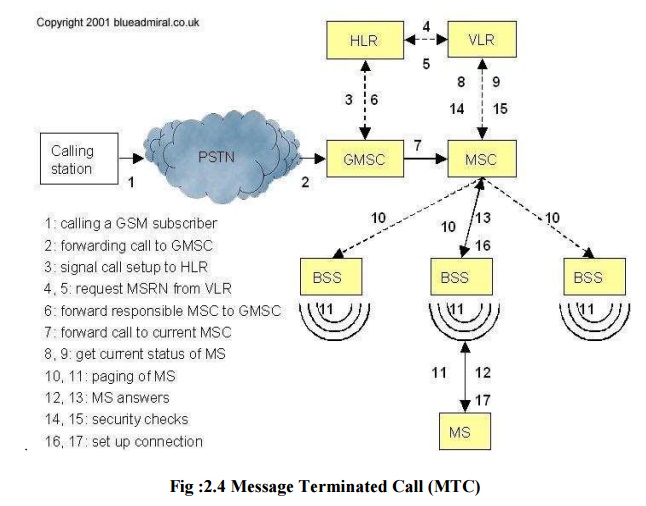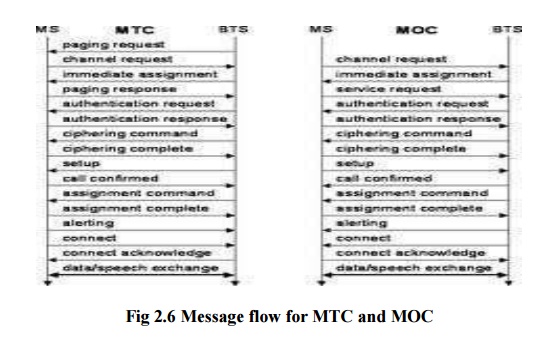Chapter: Mobile Networks : Cellular Wireless Network
Connection Establishment
CONNECTION ESTABLISHMENT:
The
number dialed to reach a mobile subscriber (MSISDN) contains no information at
all about the current location of the subscriber. In order to establish a
complete connection to a mobile subscriber, however, one must determine the
current location and the locally responsible switch (MSC). In order to be able
to route the call to this switch, the routing address to this subscriber (MSRN)
has to be obtained. This routing address is assigned temporarily to a
subscriber by its currently associated VLR. At the arrival of a call at the
GMSC, the HLR is the only entity in the GSM network which can supply this
information, and therefore it must be interrogated for each connection setup to
a mobile subscriber. An ISDN switch recognizes from the MSISDN that the called
subscriber is a mobile subscriber, and therefore can forward the call to the
GMSC of the subscriber's home PLMN based on the CC and NDC in the MSISDN. This
GMSC can now request the current routing address (MSRN) for the mobile
subscriber from the HLR using the MAP . By way of the MSRN the call is
forwarded to the local MSC, which determines the TMSI of the subscriber and
initiates the paging procedure in the relevant location area . After the MS has
responded to the paging call, the connection can be switched through.Several
variants for determining the route and interrogating the HLR exist, depending
on how the MSRN was assigned and stored, whether the call is national or
international and depending on the capabilities of the associated switching
centers.
To locate
a MS and to address the MS, several numbers are needed:
MOBILE STATION INTERNATIONAL ISDN NUMBER (MSISDN):
The only
important number from the user of GSM is phone number. Remember that the phone
number is not associated with certain device but with the SIM, which is
personalized for user. The number consist of country code(CC) as eg.+49 179
1234567 with 49 for germany. National Destination Code (NDC) is used to locate
the network provider and Subscriber number.
INTERNATIONAL MOBILE SUBSCRIBER IDENTITY(IMSI):
GSM uses
the IMSI for internal unique identification of a subscriber. IMSI consist of a
mobile country code (MCC) and mobile network code(MNC) and finally the mobile
subscriber identification number(MSIN).
TEMPORARY MOBILE SUBSCRIBE IDENTITY(TMSI):
To hide
the IMSI, which would give away the exact identity of user signaling over the
air interface, GSM uses the 4 byte.TMSI is selected by current VLR and is only
valid temporarily and within location area of VLR.
MOBILE STATION ROAMING NUMBER (MSRM):
Another
temporary address which hides the identity and location of a subscriber is
MSRN. The VLR generates this address on request from MSC, and the address is
stored in the HLR . MSRN contains current visitory and visitor national
destination code(VNDC).
MESSAGE TERMINATED CALL (MTC):
This
figure shows the basic steps needed to connect the calling station with the
mobile user.

Step 1: A
user dials the phone number of GSM subscriber. The fixed network PSTN notices
that the number belongs to the user in the GSM network and forwards the call
setup to the Gateway MSC .
Step 2:
The GMSC identifies the HLR for the subscriber and signals the call setup to
the HLR.
Step 3:
The HLR now checks whether the number exists and whether the user has subscribed
to the requested services, and the requests an MSRN from the current VLR.
Step 4 :
After receiving the request from MSRN
Step 5 :
HLR can determine the MSC responsible for the MS and forwards this information
to GMSC
Step 6 :
GMSC can now forward the call setup request to MSC indicated.
Step 7:
From this, MSC is responsible for all further steps. First it requests the
current status of MS from VLR.
Step 8 :
If MS is available, then MSC initiates paging in all cells it is responsible
for as searching for the right cell would be too time consuming.
Step 9:
This approach puts some load on signalling channels so optimization exist.
Step 10 :
Location area (LA) can be determined.
Step 11 :
The BTSs of all BSSs transmit this paging signal to MS.
Step 12
& 13 : If MS answers ( 12 and 13) the VLR has to perform security checks
set up be encryption techniques.
Steps 14
to 17 : The VLR signals to MSC to setup a connection to MS.
MESSAGE ORIGINATED CALL (MOC):
It is
simpler to perform message originated call(MOC)
compared
to MTC.

The basic
steps for MOC are,
Step 1:
MS transmits a request for a new connection.
Step 2:
BSS forwards the request to MSC.
Steps 3
& 4 : MSC then checks if the user is allowed to set up a call with the requested
service(3 and 4) and checks the availability of resources through GSM network
into PSTN.
Steps 5to
8 : If all resources are available, MSC sets up a connection between MS and
fixed network.
Steps 9
& 10 : Its set up a call with the help of BSS and MS.
MESSAGE FLOW FOR MTC AND MOC :
In
addition to the above steps mentioned above , the other messages are exxchanged
between an MS and BTS during connection setup. These messages can be quite
often heard in radios or badly sheileded speakers as crackling noise before the
phone rings. Figure shows the message for an MTC and MOC. Paging is only
necessary for an MTC, then similar message exchanges follow. The next step
which are needed for a communication security comprises the authentication of
MS and switching to encrytpted communication
The
following steps which are mentioned in the figure denotes th euse of MSC and
MOC. If someone is calling the MS, it answers now with ‗alerting‘ that MS is
ringing and with ‗connect‘ that the user has pressed the connect button. The
same actions happen the other way round if MS has initiated the call. Af.ter
connection acknowledgement both parties are exchanged.

Related Topics